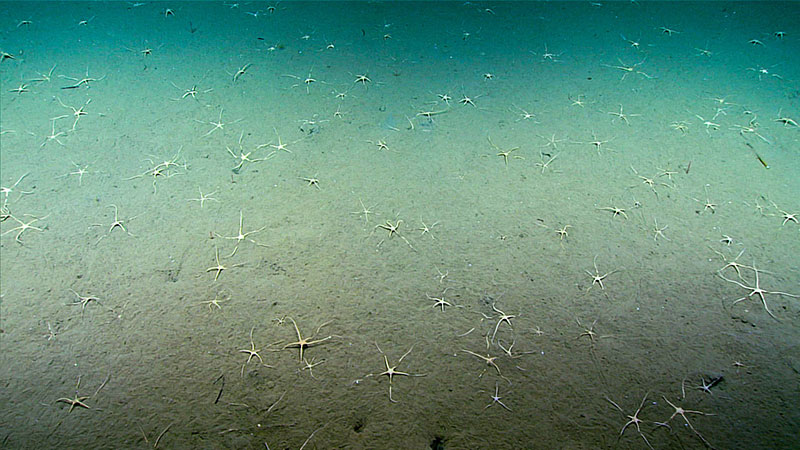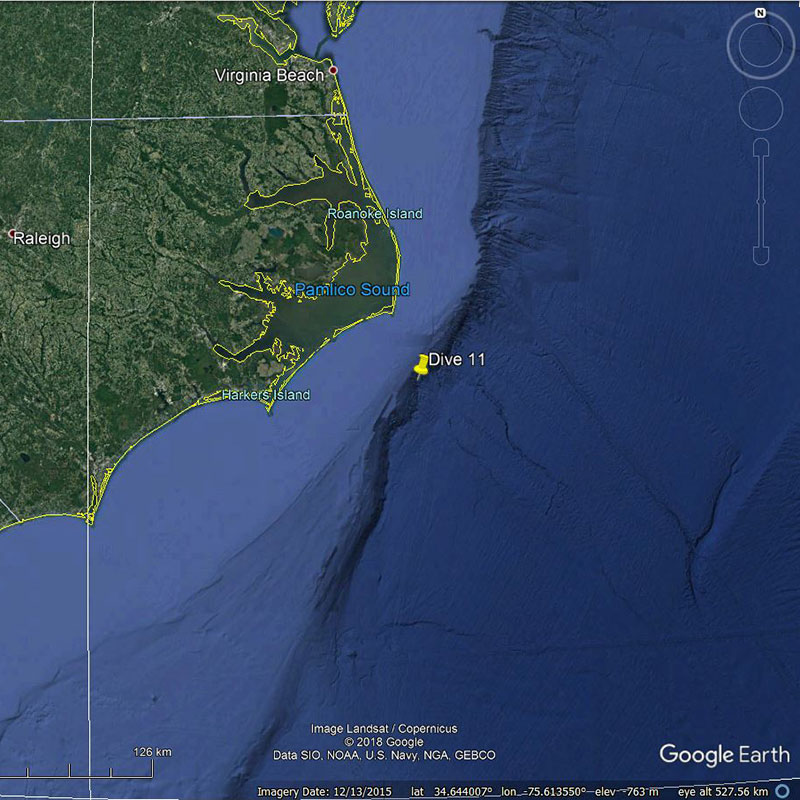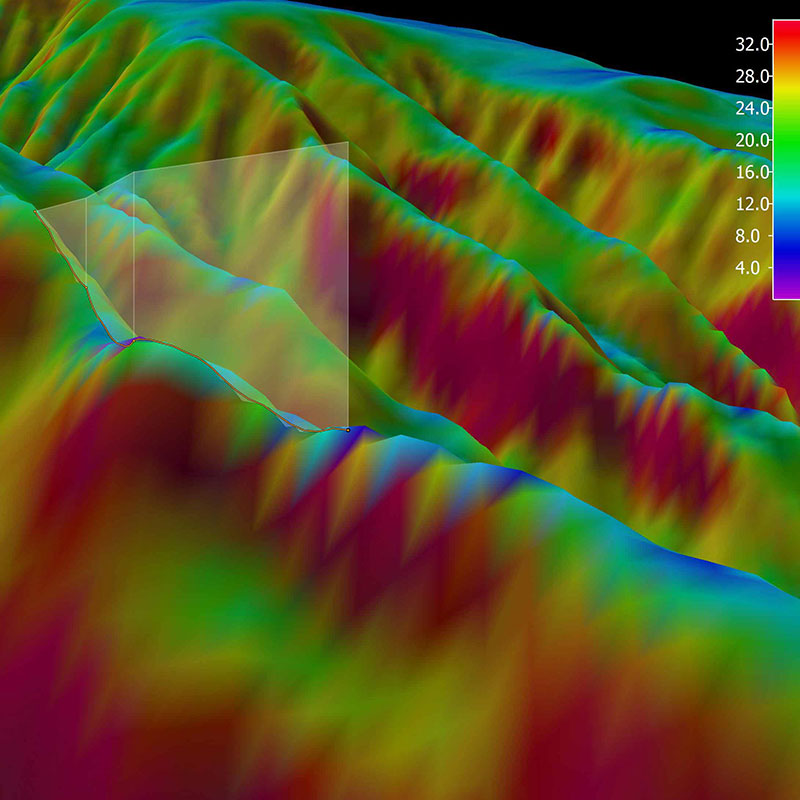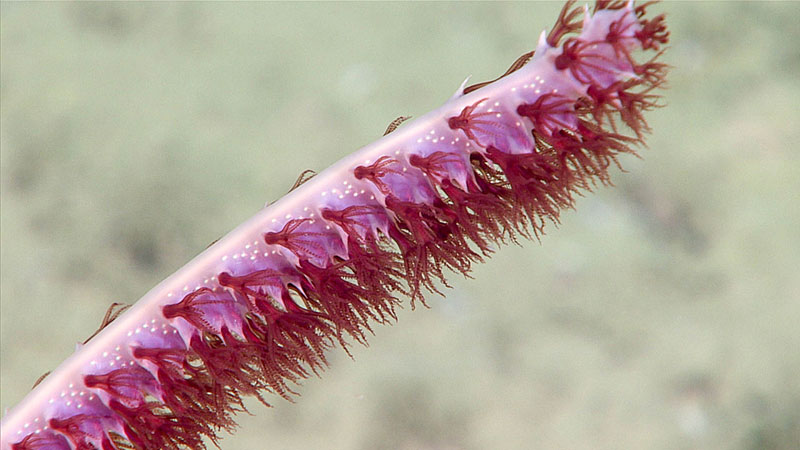Date: June 25, 2018
Location: Lat: 34.77385010°, Lon: -75.34262901°
Dive Depth Range: 1,481 - 1,716 meters (4,859 - 5,630 feet)
Loading the player...
Dive 11: A Bad Day to be a Brittle Star
During Dive 11, we observed this lithodid crab, which is a type of king crab, feasting on a brittle star. While a bit graphic to watch the crab pull the hapless brittle star apart, being able to witness predation events such as this offers scientists unique glimpses into the lives and behaviors of animals of the deep.
Video courtesy of the NOAA Office of Ocean Exploration and Research, Windows to the Deep 2018. Download larger version (mp4, 44.0 MB).
Today’s dive was on a steep rocky ridge within a submarine canyon that lies between two unnamed canyons, southwest of Pamlico Canyon, about 52 kilometers away from Cape Hatteras. This site was proposed by the DEEP SEARCH project team with the goal of investigating the biological fauna in a canyon feature that had yet to be explored in detail. High-resolution multibeam sonar surveys by NOAA Ship Okeanos Explorer were conducted in this region as part of the Atlantic Canyons Undersea Mapping Expeditions (ACUMEN) campaign in 2012. In 2016, the Exploring Carolina Canyons expedition surveyed a handful of locations in the canyons off North Carolina; however, this area of elongated ridges that formed minor canyons had never been explored before. The primary objective of today’s dive was to characterize and survey the seafloor for benthic fauna in an effort to better understand what type of habitat these ridge features create and the animals that live there. This area of interest had some of the steepest slopes investigated so far on the Windows to the Deep 2018 expedition.
Remotely operated vehicle (ROV) Deep Discoverer was the first to explore this area and was on the seafloor from 13:33:42 - 19:36:24 UTC. Today’s dive was surprisingly different in that the seafloor surveyed for the entire dive, over a distance of approximately 1,000 meters (about 3,281 feet), consisted of thick fine-grained sediments covered with brittle stars. Due the lack of hard substrate, no stony corals were observed during the dive.

At the start of Dive 11 of the Windows to the Deep 2018 expedition, the remotely operated vehicle (ROV) Deep Discoverer imaged a very high density of brittle stars on the thick fine-grained sediment of the seafloor. Image courtesy of the NOAA Office of Ocean Exploration and Research, Windows to the Deep 2018. Download larger version (jpg, 785 KB).
The dive began at around 1,712 meters (about 5,617 feet) depth and the ROV ascended the steeply sloped leeward side of an intra-canyon ridge. Then the ROV worked its way up the backbone of the ridge, finishing the dive at a depth of around 1,481 meters (4,859 feet). The ophiuroids (brittle stars) had the highest density and the sea pens had the most diversity seen throughout the dive. Other organisms seen during the dive included pycnogonids (sea spiders), holothurians (sea cucumbers), tripod fish, cutthroat eels, cusk eels including one that appeared to be hiding out below an urchin, sea stars, cup corals, octocorals, crabs, and hermit crabs including one with an anemone as a shell. This is a mutualistic relationship as the anemone stinging cells can provide the crab with added protection from predators and the anemone gets the benefit of transportation along the seafloor. One of the sea pens imaged during the dive appeared to be feeding as some of its tentacles were curled into its mouth.
During the dive, a geological collection of the sediment and biological collection of a sea pen were made. This sea pen collected was observed during the Northeast U.S. Canyons 2013 expedition further north in the Atlantic Ocean and this might be a range extension for the species. This sea pen had white dots along its body which are syphonozoids (highly modified polyps without tentacles). These polyps can hold eggs or funnel water through the organism. Another highlight of the dive was a lithodid crab consuming a brittle star in graphic detail. With the dive complete and the ROV back onboard, NOAA Ship Okeanos Explorer is heading offshore and mapping en route to a deeper site called Pamlico Deep. Stay tuned for more live deep-sea tv.



